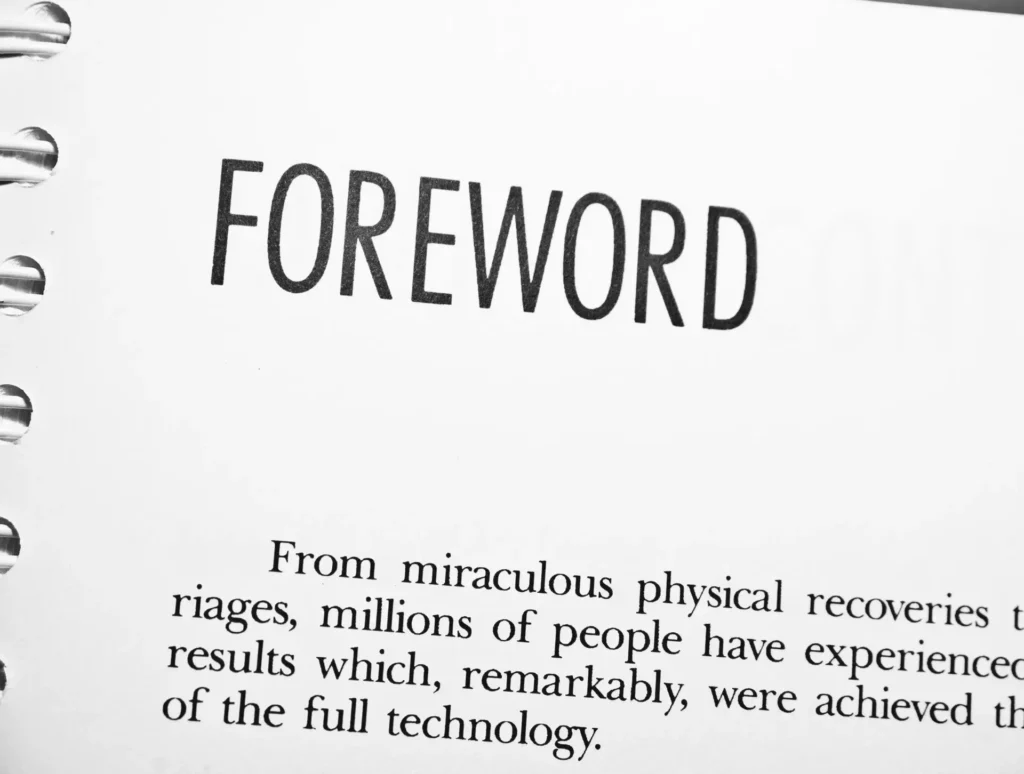Forward vs. Foreword
In the vast and intricate landscape of the English language, the words forward vs. foreword emerge as a classic example of homophones—words that sound alike but have different meanings and spellings. This subtle distinction holds significant importance, particularly in contexts where precision in language is paramount.
“Forward” is commonly used as an adverb or adjective, denoting direction towards the front, advancement in time, or towards improvement. In contrast, “foreword” is a noun specific to the literary world, referring to a short introductory section in a book, often penned by someone other than the author, that sets the stage for the following text.
Confusing these terms can lead to misunderstandings, especially in written communication, underscoring the need for clarity. This article aims to untangle forward vs. foreword, offering insights into their correct usage to enhance the accuracy and richness of our communication. By diving into the nuances of these terms, we refine our understanding and celebrate the depth and diversity of English vocabulary.

Part 1: Understanding Forward vs. Foreword
Embarking on the journey to distinguish between forward vs. foreword begins with a foundational understanding of their definitions, grammatical roles, and the contexts that summon their use. This initial exploration sets the stage for their accurate application, guiding us toward more precise and effective communication.
Definitions and Roles
- Forward: As an adverb and adjective, “forward” signifies movement towards the front or in the direction one is facing. It also denotes advancement towards a future point in time or towards a successful outcome. In various contexts, “forward” embodies progress, whether it’s in physical space, time, or development.
Example as an Adverb: “The team is moving forward with the project despite the challenges.”
Example as an Adjective: “She always had a forward-thinking approach to business.” - Foreword: As a noun, “foreword” is a preliminary section of a book, typically positioned before the main text. It provides readers with insights, background information, or personal commentary, usually written by someone other than the book’s author, such as a notable figure in the field.
Example: “The foreword by the esteemed historian adds depth to the narrative, offering a broader context for the events described in the book.”
Grammatical Rules and Usage Guidelines
Differentiating forward vs. foreword hinges on the nature of what’s being described—direction and advancement for “forward” versus an introductory section of text for “foreword”:
- Contextual Application: Use “forward” when referring to direction, advancement, or a progressive state. Opt for “foreword” when discussing the specific introductory segment of a book that precedes the main text.
- Recognizing the Subject Matter: The key to choosing correctly between “forward” and “foreword” often lies in the subject matter—movement and progress versus literary introductions.
By clearly understanding forward vs. foreword, we lay the foundation for their practical and appropriate use. This knowledge not only aids in circumventing common errors but also empowers us to articulate our thoughts with greater clarity and precision, whether discussing progress or prefacing a literary work.

Part 2: Using “Forward”
“Forward” is a versatile term that propels our language towards action and progression. Its dual role as an adverb and adjective allows it to describe movement, direction, and advancement in various contexts, making it a staple in our linguistic toolkit for expressing dynamic concepts.
“Forward” for Direction and Progress
- Purpose and Application: Employ “forward” to denote movement towards the front or future or indicate a progression in ideas, technology, or societal norms. Its use enriches language by adding a sense of motion and advancement.
Example as an Adverb: “Let’s move forward with the plan, focusing on the next steps.”
Example as an Adjective: “Her forward-looking perspective was crucial in adapting to the market changes.”
Common Contexts for “Forward”
Understanding the scenarios that commonly call for “forward” ensures its correct application and reinforces the intended message of progression or advancement:
- Directions and Instructions: In physical or metaphorical guidance, “forward” suggests a direction to proceed towards.
Example: “To advance to the next level, you must move forward through the maze.” - Innovation and Progress: “forward” symbolizes cutting-edge thinking and progress when discussing ideas or developments.
Example: “The company’s forward-thinking policies have set new industry standards.”

Part 3: Using “Foreword”
While “forward” pushes us towards action and progression, “foreword” anchors us in literature, illuminating the insights and perspectives that frame a book. This literary component serves as a bridge between the reader and the author’s world, enriched by the contributions of another voice.
“Foreword” for Book Introductions
- Purpose and Application: Utilize “foreword” to refer to the introductory section of a book, where insights, context, or endorsements are provided, often by someone other than the author. This section sets the tone or offers a preparatory commentary for the reader.
Example: “The foreword, penned by a leading expert in the field, offers a compelling introduction to the book’s themes.”
Differentiating “Foreword” from “Forward”
The key to employing “foreword” correctly lies in its exclusive association with literature, distinct from the directional or progressive implications of “forward”:
- Literary Introductions: “Foreword” is used explicitly in the context of books to describe a preliminary section that often provides background, context, or a personal touch from a perspective other than the author’s.
Example: “The novelist included a foreword by her mentor, shedding light on the novel’s genesis and themes.”
Parts Two and Three delve into the nuanced uses of forward vs. foreword, highlighting their appropriate application in expressing direction, advancement, and literary introductions. By understanding each term’s distinct contexts and implications, communicators can more accurately express concepts of progression or provide readers with a meaningful entry into a literary work. Mastery of forward vs. foreword clarifies our communication. It enriches our ability to convey the nuances of movement and introduction, whether in the realm of ideas or the pages of a book.

Part 4: Common Mistakes and How to Avoid Them
The similarity in sound between forward vs. foreword can lead to common errors in writing, where their distinct meanings may become blurred. Ensuring accurate use clarifies the intended message and showcases attention to detail and mastery over language nuances.
Confusing “Forward” and “Foreword”
One prevalent mistake involves interchanging forward vs. foreword. Such a mix-up can obscure whether the reference is to progression and direction or a literary introductory section.
- Strategy for Avoidance: Remember that “forward” relates to direction, progression, and future-oriented action, while “foreword” is a specific term used in the context of books. Remembering “foreword” as something that comes “before the word” (main text) can help cement its literary significance.
Overlooking Contextual Cues
Failing to consider the broader context of the communication might lead to inappropriate usage of forward vs. foreword. Contextual cues are vital in determining which term is suitable for the intended meaning.
- Clarification Tip: Before choosing between forward vs. foreword, assess the context of your sentence or narrative. Is the discussion about moving ahead or about a piece of writing? The answer will guide your word choice.
Tips for Correct Usage
Navigating the distinction between forward vs. foreword enhances the quality of communication, allowing for the precise expression of ideas or literary elements.
- Proofreading and Review: Always proofread your writing for potential mix-ups between forward vs. foreword. A second look can catch errors that might confuse readers.
- Practice Writing: Incorporate forward vs. foreword in writing exercises, focusing on their distinct meanings. Practice reinforces correct usage.
- Seek Feedback: Don’t hesitate to ask for feedback on using forward vs. foreword. Insights from peers or mentors can provide clarity and improve understanding.
Conclusion
The exploration of forward vs. foreword not only unravels the confusion surrounding these homophones but also highlights the richness of the English language. Understanding and correctly applying these terms enables us to communicate more effectively, whether discussing concepts of advancement and direction or introducing readers to the nuances of a literary work. This journey through the specific uses of forward vs. foreword is a testament to the importance of precision in language, encouraging us to pay close attention to the chosen words and their meanings.
Embracing Linguistic Precision
Let this examination of forward vs. foreword inspire a broader commitment to linguistic precision in all aspects of communication. As we continue to navigate the complexities of vocabulary and syntax, let us appreciate the opportunities to enhance clarity and depth in our expression, one word choice at a time.
The Path Forward
Challenge yourself to distinguish clearly between forward vs. foreword in your communications, using this understanding as a foundation for broader linguistic accuracy. Explore, question, and refine your language choices, celebrating the clarity and expressiveness that comes from meticulous attention to detail. Through mindful practice and ongoing exploration, we can all contribute to the art of clear and impactful communication.

Further Exploration
For those eager to dive deeper into the intricacies of English, countless resources await. From comprehensive grammar guides to interactive language learning platforms, the tools at your disposal are more accessible than ever. Engage with these materials, challenge yourself with new exercises, and remain curious and open to discovery. We offer a line of comprehensive grammar and punctuation courses and feature a mastery quiz bundle to cement your further mastery of grammar and punctuation. Feel free to access the endorsed resources below to enhance your learning experience.





